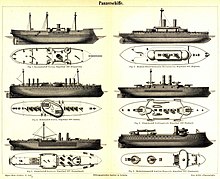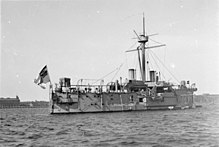Ironclad
The term ironclad denotes different types of armored warships . In particular, armored ship is used as an umbrella term for the armored steam-powered warships in the second half of the 19th century.
overview
With the development of the bomb cannon , which could fire explosive projectiles , wooden warships no longer had sufficient resistance to fire. This was shown in the battle at Eckernförde on April 5, 1849, in the sea battle at Sinope on November 30, 1853 and during the bombardment of Sevastopol on October 17, 1854. The armored floating batteries developed by France Tonnante , Lave and Dévastation showed at the Bombardment of the Russian fort Kinburn on October 17, 1855, that ships with iron armor were able to withstand bomb cannons. Then the sea powers began to build armored ocean-going ships. France made the start in 1859 with the armored wooden ship La Gloire . Britain responded with the armored steel ships Warrior and Black Prince . The first German ironclad was the tower ship Arminius of the Royal Prussian Navy launched in London in 1864 .
The first battle between armored warships occurred in the American Civil War in the Battle of Hampton Roads between the Monitor and Virginia .
The technical progress in the era of the industrial revolution enabled rapid development, especially in artillery , armor protection and propulsion. As a result, there was great uncertainty in tactical and technical questions. It was reflected in a large number of drafts, which also makes a classification of the ships extremely difficult. It was not until the end of the 19th century that established standard types began to establish themselves with the unit ship of the line , the armored cruiser and the protected cruiser .
Development of ship types
The first armored warships were so-called tank frigates such as the Gloire and the Warrior . The name frigate was derived from the placement of the guns on a single battery deck, but they were the main combat ships of the respective fleets. The guns stood on a battery deck as they had for centuries and fired through gun ports in the armor. Due to the placement of the guns, the ships were also known as battery or broadside ships . The armor on the side walls consisted of 100 to 200 mm thick wrought iron.
In the case of guns, the use of larger calibers soon led to a reduction in the number of them. They were set up in the middle of the ship in a shortened "central battery" (hence central battery ships ), but they could still only fire crossways. In order to achieve greater stroking angles for the heavy artillery, the side walls were drawn in in front of and behind the central battery so that the guns at the ends of the battery could also fire forwards and backwards ( casemate ships ).
Already at the beginning of the Civil War , so-called ram ships were developed in both the northern and southern states , which are ironclad ships with a ram ( English : ram , metaphorical for rams ). The first ship of this type and the first ironclad on the American continent was the Manassas , which entered service in 1861.
The next development step was the French barbed ship Amiral Duperré , launched in 1879. This carried its main armament consisting of four 34 cm guns rotatable in open-top armored barbeds . The middle artillery of fourteen 14-cm guns was arranged unprotected in a broadside arrangement in a battery deck. In addition to a 300 mm thick barbed armor, the Amiral Duperré had a waterline armor of 559 mm and, because of the increasing firing range, an armored deck of 60 mm thick. The installation of the guns so that they could be rotated in barbeds or in rotatable towers (see tower ships below), together with the elimination of the sail rigging, enabled greatly improved stroking angles.
With the increasing penetration of the ship's artillery it was necessary to increase the thickness of the armor and thereby reduce the size of the armored surfaces to compensate for the weight. This led to the attempt to combine the vital parts (artillery, magazines and propulsion) in the smallest possible space in a central armored citadel ( citadel ships ). The parts of the ship in front of and behind the citadel were to be protected from catastrophic water ingress by an armored deck lying below the waterline and a good watertight subdivision. Examples are the German Sachsen class from 1877 (referred to in the Imperial Navy as “ Panzer Corvettes ” or “Emergency Corvettes”) and the Italian Italia from 1880, armed with four 43.2 cm guns. In terms of gun placement, both ships can still be classified as Barbed ships are called.
A parallel development in terms of gun placement was the so-called tower ships , which carried their guns in rotating, closed armored turrets. The first tower ship was the Danish Rolf Krake . The best-known representative is the Monitor from 1862. A type of ship is named Monitor after it . They were used to defend coastlines and rivers. They were characterized by the fact that the hull only barely protruded from the water - with so-called river monitors this was often only a few centimeters, e.g. B. in the German Rhine class from 1872.
Since the armored towers represented a large mass, they had to be set up comparatively low in the ship. This usually led to a low freeboard and thus to a restricted seaworthiness, which led to the sinking of the British tower ship Captain in the storm off Cap Finisterre on September 6, 1870 .
Around 1890, the development of the various types of ironclad came together. A type of armored main battle ship developed, which was similar in all fleets and was later referred to as a unit ship of the line.
Armor
In the period under review, the ships were armored against flat fire due to the expected short combat distances, but not against indirect fire . This means that the vertical armor surfaces had the greatest armor thickness (up to 60 cm iron or steel, depending on the material), while the horizontal armor was only a few centimeters thick. The further development of the artillery made it necessary to continuously improve the armor protection of the ships. In addition to the concentration of armor described above, the constant further development of armor material contributed to this.
The first ironclad ships were protected by armor made of wrought iron , which usually consisted of several plates riveted to one another (lamellar armor). From around 1865, roller iron was used as armor material. For these and later types of tanks up to the Second World War , a hardwood backing was typical, which was intended to absorb chips on the back of the armor plate caused by hits.
When the rolled iron plates used had reached the maximum producible thickness, several layers of iron and hardwood were alternately placed one behind the other and so came the so-called sandwich tank (see diagram of the tank of the Sachsen-class emergency corvettes on the right; the tank was 85 in total, 6 cm, of which 40.6 cm are armor plates).
In 1877, the so-called. Has been in the UK Compound- or composite armor developed. To do this, steel plates were welded to the outside of rolled iron plates (ie the side facing the impacting projectile). The hardness of the steel should destroy or reject the opposing projectile, while the support of more elastic roller iron should prevent the steel plate from shattering. The pure steel armor that appeared at the same time was sometimes viewed as inferior due to its brittleness.
Hardened nickel steel armor began to gain acceptance around 1890 (first introduced in 1889 by the French company Schneider Electric ). The alloy of steel with nickel increased both its hardness and its toughness.
A major step forward was the Harvey armor, which was developed in the USA from 1891 and made from nickel steel plates . In this case, the outside of the armor plate was particularly hardened, while the back of the plate was comparatively elastic. Thus the armor plate had similar properties to the composite armor. This was achieved by increasing the carbon content of the steel on the outside from 0.1% to 0.2% to approx. 1% and by suddenly cooling the outside after heating. Krupp improved this process several times between 1892 and 1895 by using chrome-nickel steel and improved quenching of the hardened plate side.
If one compares different sources, one comes to the following ratio of the protective effect of different types of armor: 300 mm iron armor corresponds to 200 mm composite armor corresponds to 125 mm harvey armor corresponds to 100 mm croup armor. This means that with armor manufactured according to the Krupp process, only a third of the mass of iron armor had to be used for the same protective effect.
photos
HMS Warrior (1860)
USS Cairo (1862)
Huáscar (Peru, 1865)
Hoche (around 1890)
literature
- Jochen Brennecke, Herbert Hader: Ironclad ships and ships of the line 1860-1910 . Köhlers Verlagsgesellschaft, Herford 1976, ISBN 3-7822-0116-7 .
- Siegfried Breyer: Battleships and battle cruisers 1905–1970 license ed. of Lehmanns Verlag. Pawlak, Herrsching 1970, ISBN 3-88199-474-2 .
- Ulrich Israel, Jürgen Gebauer: Warships in the 19th century . Gondrom-Verlag, Bindlach 1989, ISBN 3-8112-0626-5 .
- Ulrich Israel, Jürgen Gebauer: Ironclad ships around 1900 . 2nd revised edition. Brandenburgisches Verlagshaus, Berlin 1998, ISBN 3-89488-027-9 .
- Jack Greene / Alessandro Massignani: Ironclads at War. The Origin and Development of the Armored Warship, 1854-1891 , Conshocken, PA 1998, ISBN 978-0-938289-58-6 .
Web links
- Description of the historical development of the armor material
- The first ironclads 1859–1872
- Federal archive - file: tank frigates King Wilhelm, Crown Prince and Friedrich Carl, as well as the corvette Augusta (Source: BArch B 134 / B 864)
- Federal Archives - Image: Tank frigates King Wilhelm, Crown Prince and Friedrich Carl, as well as the corvette Augusta (Source: BArch B 134 / B 864)











